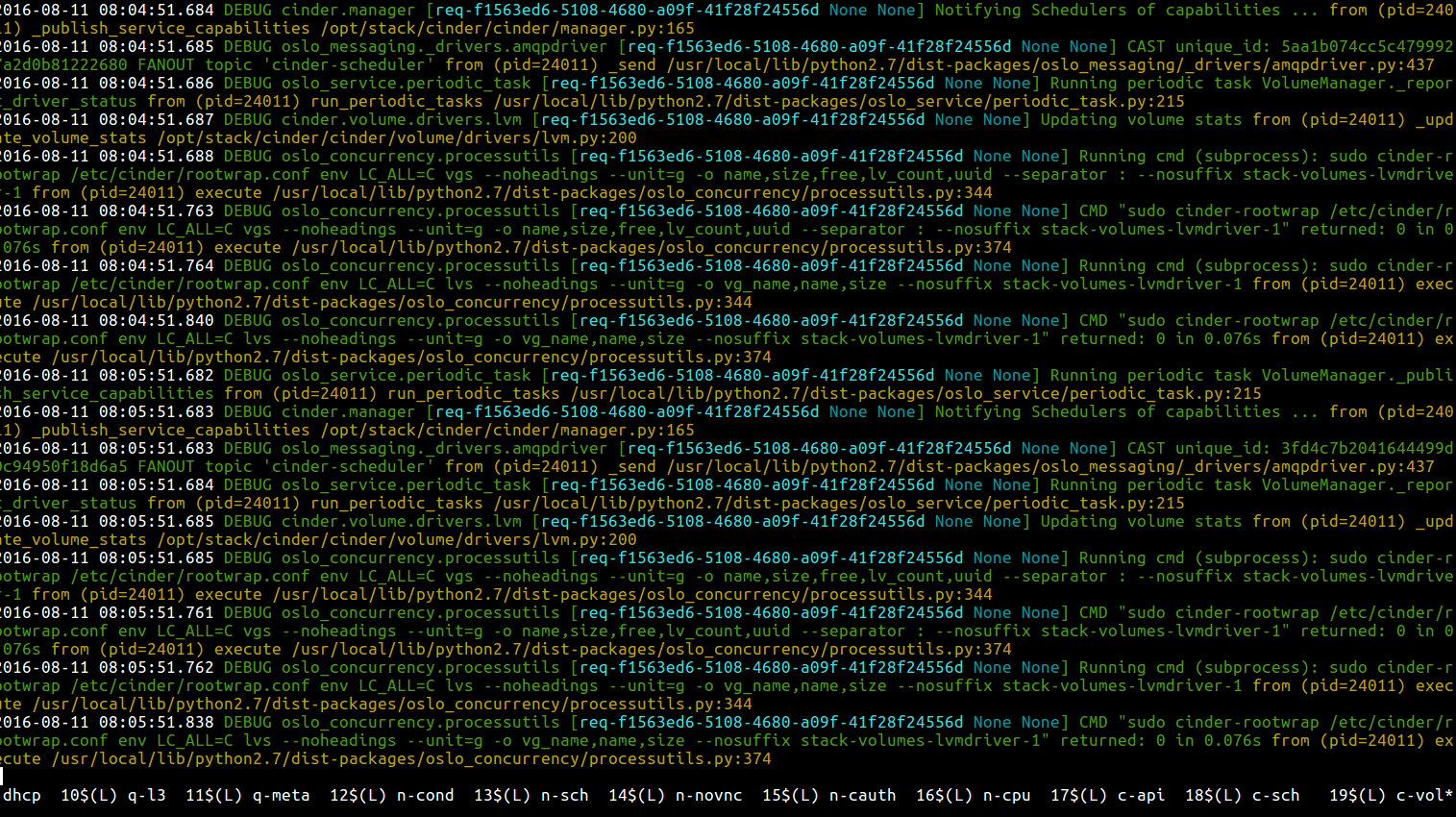Developing with Devstack¶
Now that you have your nifty DevStack up and running, what can you do with it?
Inspecting Services¶
By default most services in DevStack are running in a screen session.
os3:~> screen -list
There is a screen on:
28994.stack (08/10/2016 09:01:33 PM) (Detached)
1 Socket in /var/run/screen/S-sdague.
You can attach to this screen session using screen -r which gives
you a view of the services in action.

Basic Screen Commands¶
The following minimal commands will be useful to using screen:
ctrl-a n- go to next window. Next is assumed to be right of current window.ctrl-a p- go to previous window. Previous is assumed to be left of current window.ctrl-a [- entry copy/scrollback mode. This allows you to navigate back through the logs with the up arrow.ctrl-a d- detach from screen. Gets you back to a normal terminal, while leaving everything running.
For more about using screen, see the excellent screen manual.
Patching a Service¶
If you want to make a quick change to a running service the easiest way to do this is:
- attach to screen
- navigate to the window in question
ctrl-cto kill the service- make appropriate changes to the code
up arrowin the screen window to display the command used to run that serviceenterto restart the service
This works for services, except those running under Apache (currently
just keystone by default).
Warning
All changes you are making are in checked out git trees that DevStack thinks it has full control over. Uncommitted work, or work committed to the master branch, may be overwritten during subsequent DevStack runs.
Testing a Patch Series¶
When testing a larger set of patches, or patches that will impact more than one service within a project, it is often less confusing to use custom git locations, and make all your changes in a dedicated git tree.
In your local.conf you can add **_REPO, **_BRANCH for most projects
to use a custom git tree instead of the default upstream ones.
For instance:
[[local|localrc]]
NOVA_REPO=/home/sdague/nova
NOVA_BRANCH=fold_disk_config
Will use a custom git tree and branch when doing any devstack
operations, such as stack.sh.
When testing complicated changes committing to these trees, then doing
./unstack.sh && ./stack.sh is often a valuable way to
iterate. This does take longer per iteration than direct patching, as
the whole devstack needs to rebuild.
You can use this same approach to test patches that are up for review in gerrit by using the ref name that gerrit assigns to each change.
[[local|localrc]]
NOVA_BRANCH=refs/changes/10/353710/1
Testing Changes to Apache Based Services¶
When testing changes to Apache based services, such as keystone,
you can either use the Testing a Patch Series approach above, or make
changes in the code tree and issue an apache restart.
Testing Changes to Libraries¶
When testing changes to libraries consumed by OpenStack services (such as oslo or any of the python-fooclient libraries) things are a little more complicated. By default we only test with released versions of these libraries that are on pypi.
You must first override this with the setting LIBS_FROM_GIT. This
will enable your DevStack with the git version of that library instead
of the released version.
After that point you can also specify **_REPO, **_BRANCH to use
your changes instead of just upstream master.
[[local|localrc]]
LIBS_FROM_GIT=oslo.policy
OSLOPOLICY_REPO=/home/sdague/oslo.policy
OSLOPOLICY_BRANCH=better_exception
Because libraries are used by many services, library changes really
need to go through a full ./unstack.sh && ./stack.sh to see your
changes in action.
To figure out the repo / branch names for every library that’s supported, you’ll need to read the devstack source.